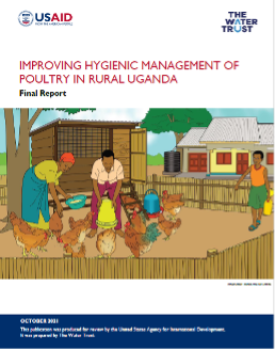Typical poultry management practices in rural Uganda expose children to fecal contamination and increased risk of disease. Yet there is little to no robust evidence on how these behaviors might be changed, and what impact behavior change might have on fecal contamination in the home environment and prevalence of disease. In 2019, USAID’s Water, Sanitation, And Hygiene Partnerships And Learning For Sustainability (WASHPALS) and The Water Trust developed and implemented a poultry management training intervention across 51 communities in western Uganda. The program was designed in consultation with a rural livelihood training center in Uganda and with inputs from focus group discussions with rural communities in western Uganda. The training intervention integrated behavior change messaging on both health and livelihood risks of current daytime and night-time management practices and included practical group training exercises on low-cost behaviors that households can undertake to reduce these risks.
The program was evaluated by a randomized controlled trial led by Dr. Ayse Ercumen and Dr. Angela Harris of North Carolina State University. The trial was conducted in areas where The Water Trust had previously formed savings groups within communities to maintain their shared water point. The communities had received hygiene and sanitation promotion (without messaging on poultry feces) prior to this intervention. Villages in these areas were block-randomized by parish into intervention vs. control groups. Among 126 communities within 42 villages, communities with more than 30 households were selected to participate in the trial, resulting in a total of 100 communities (51 intervention, 49 control). Poultry training activities in the 51 intervention communities were open to savings group members as well as non-members. In total, 1,658 people were trained across 51 communities, with women constituting 59 percent of the trainees. In each community, households that were savings group members and had a child under the age of 5 years were enrolled systematically in the randomized controlled trial using The Water Trust membership rosters, for a total of 1305 households (664 intervention, 641 control). Enrolled households were visited approximately 20 months after the initiation of trainings to record poultry management behaviors, infrastructure, observable poultry feces, observed free-roaming poultry and caregiver-reported health outcomes for children under the age of 5 years. Among trial participants that owned poultry, child hand rinse samples were collected to measure E. coli as an indicator of fecal contamination.
The randomized controlled trial and microbial hand rinse sample analysis found no impact of the intervention on poultry management practices, contamination of child hands, and child health. This study’s findings suggest that a training intervention is inadequate to change household management of poultry. The intervention also offered a no-interest group loan to savings groups to which the training participants belonged. Loan recipients had a higher rate of poultry enclosures than participants who did not take the loan, but the study was not powered to detect the statistical significance of this relationship. Ultimately, the intervention of training plus group loan offer had no statistical impact on enclosures in the study population one year later. One explanation for this lack of impact was that despite training messages emphasizing that several key poultry management practices (such as an outdoor chicken run made of poles and netting) could be done at very little cost, there was significant resistance to undertaking these changes in the absence of a chicken house, which is a dedicated enclosure with walls, a door, and a roof that requires more financial investment. In addition to this obstacle, our study suggests that even households that have dedicated spaces for poultry only, including chicken houses, fenced in outdoor spaces for poultry coops, and baskets, still have high rates of observable poultry feces, likely connected to traditional poultry feeding practices that allow for free-roaming animals. A key underlying challenge is that rural households are managing poultry at a scale that may be too small to justify investing in appropriate facilities and recurring food and immunization expenses given the significant risks for poultry (i.e., death by predation or disease or theft). Yet free-range small-scale backyard chicken rearing produces contamination that poses a significant health risk for children under five.


